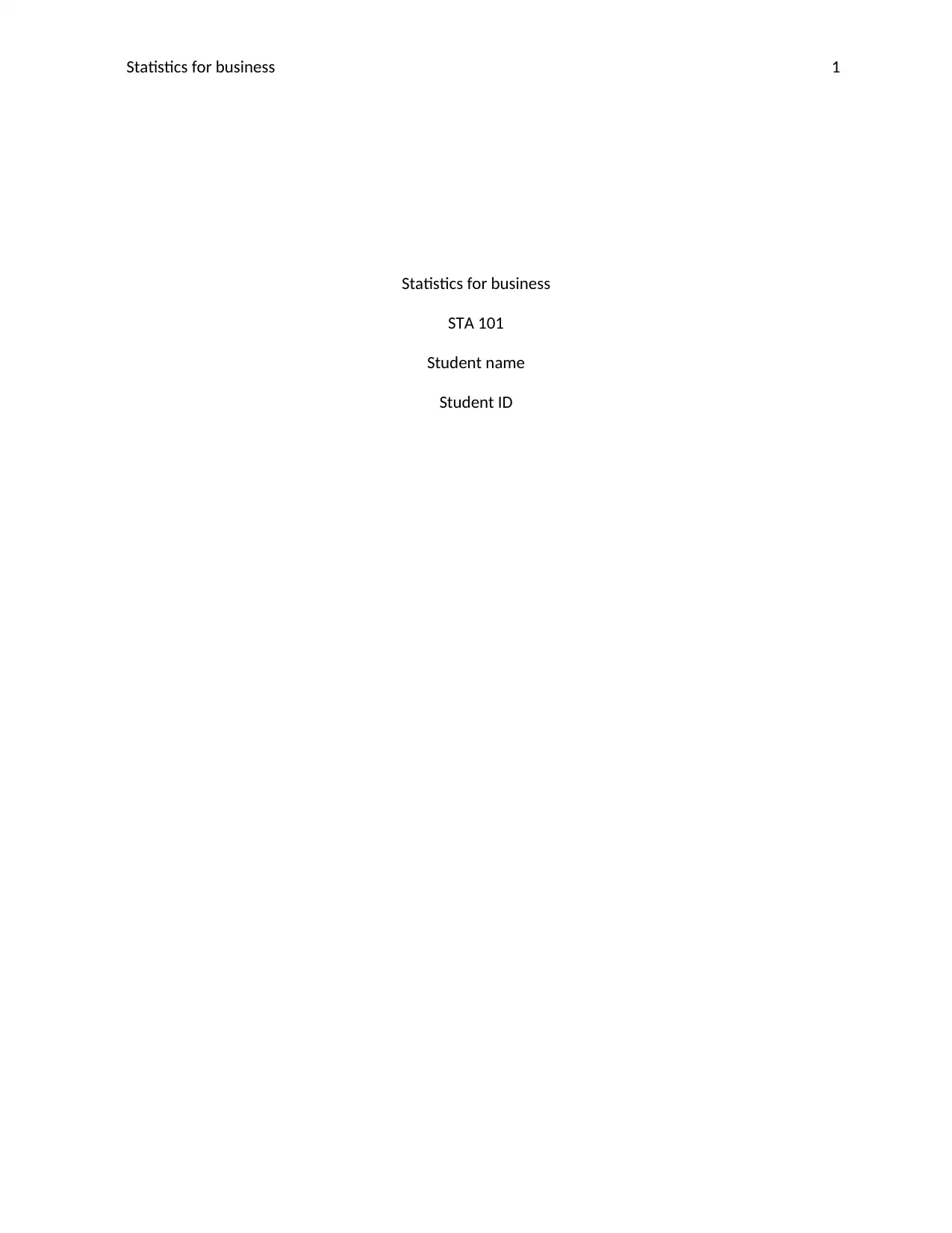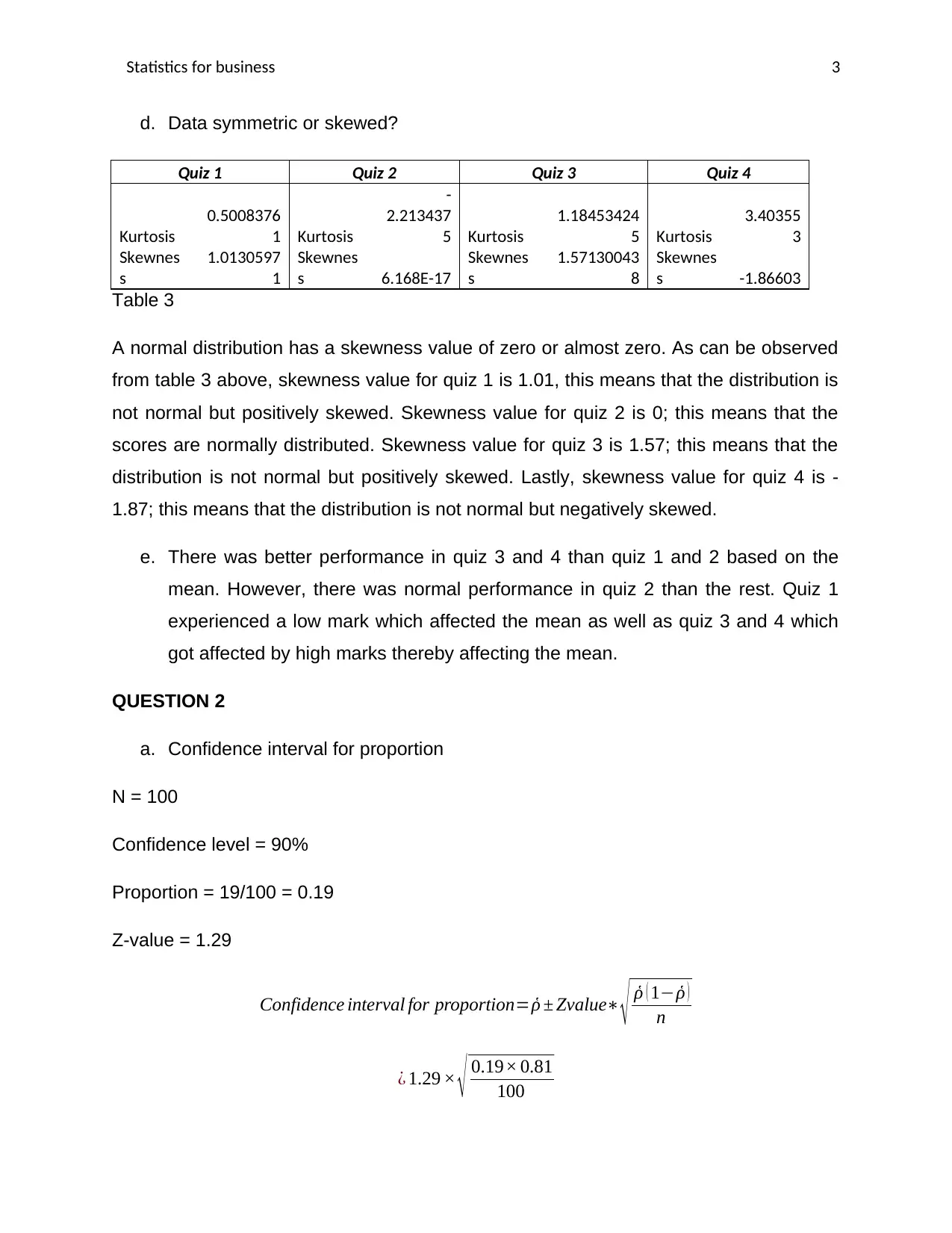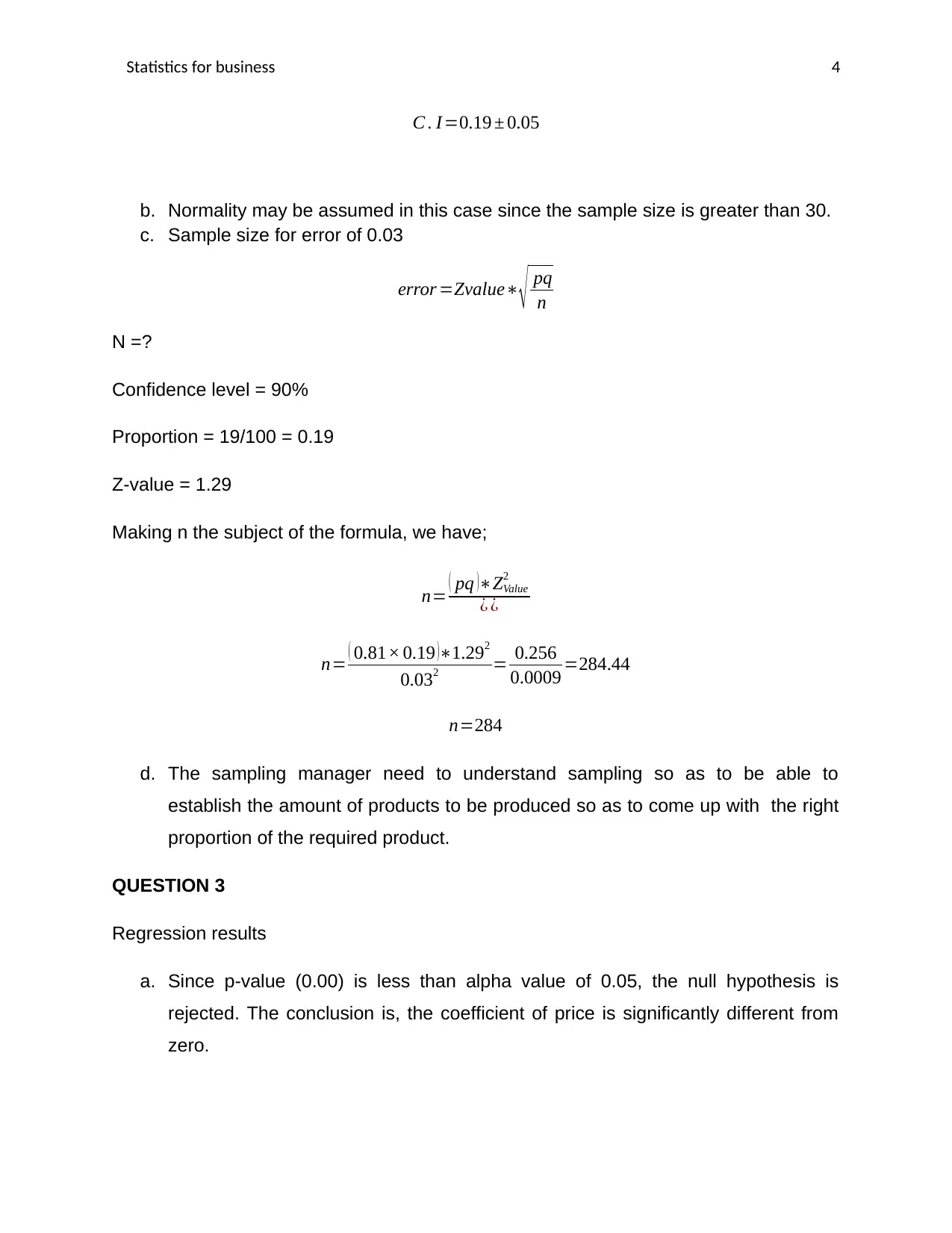University Statistics for Business: STA 101 Assignment Solution
VerifiedAdded on 2021/05/31
|5
|867
|36
Homework Assignment
AI Summary
This document presents a comprehensive solution to a statistics for business assignment (STA 101). The assignment analyzes quiz scores, calculating mean, median, mode, skewness, and kurtosis to assess data distribution and identify potential outliers. It also covers the construction of confidence intervals for proportions, demonstrating the impact of sample size on error. Furthermore, the solution interprets regression results, evaluating the relationship between price and sound quality, and tests a hypothesis about delivery times, identifying and explaining type I and type II errors. The analysis provides a clear understanding of statistical concepts and their practical application in a business context.

Statistics for business 1
Statistics for business
STA 101
Student name
Student ID
Statistics for business
STA 101
Student name
Student ID
Paraphrase This Document
Need a fresh take? Get an instant paraphrase of this document with our AI Paraphraser

Statistics for business 2
QUESTION 1
Test scores
Quiz 1 60 60 60 60 71 73 74 75 88 99
Quiz 2 65 65 65 65 70 74 79 79 79 79
Quiz 3 66 67 70 71 72 72 74 74 95 99
Quiz 4 10 49 70 80 85 88 90 93 97 98
Table 1
a. Mean, mode and median for each quiz
Below is an excel output for the measures above;
Quiz 1 Quiz 2 Quiz 3 Quiz 4
Mean 72 Mean 72 Mean 76 Mean 76
Median 72 Median 72 Median 72 Median 86.5
Mode 60 Mode 65 Mode 72 Mode #N/A
Table 2
b. The measures of center do not agree for all the four quizzes. For measures of
center to agree, the mode, median and mean should be equal. It is only in quiz 3
where the measures were almost agreeing.
c. In quiz 4, the mean the mean was not a good measure of center since it was
greatly affected by an extreme low value which is 10. The median in this case is
the best measure of center since it is always resistant to extreme values or
outliers. In quiz 3 again, the mean is not a good measure of center, it is affected
by extreme high values which are 95 and 99. The best measure in this case is
the median because it is not affected by extreme values. In quiz 1, the mean is
not a good measure of center; it is affected by extreme high values which are 88
and 99. The best measure in this case is the median because it is not affected by
extreme values. In quiz 2, the mean is the best measure of center since the data
has got no extreme values. Thus the spread of the scores is not so much
affected.
QUESTION 1
Test scores
Quiz 1 60 60 60 60 71 73 74 75 88 99
Quiz 2 65 65 65 65 70 74 79 79 79 79
Quiz 3 66 67 70 71 72 72 74 74 95 99
Quiz 4 10 49 70 80 85 88 90 93 97 98
Table 1
a. Mean, mode and median for each quiz
Below is an excel output for the measures above;
Quiz 1 Quiz 2 Quiz 3 Quiz 4
Mean 72 Mean 72 Mean 76 Mean 76
Median 72 Median 72 Median 72 Median 86.5
Mode 60 Mode 65 Mode 72 Mode #N/A
Table 2
b. The measures of center do not agree for all the four quizzes. For measures of
center to agree, the mode, median and mean should be equal. It is only in quiz 3
where the measures were almost agreeing.
c. In quiz 4, the mean the mean was not a good measure of center since it was
greatly affected by an extreme low value which is 10. The median in this case is
the best measure of center since it is always resistant to extreme values or
outliers. In quiz 3 again, the mean is not a good measure of center, it is affected
by extreme high values which are 95 and 99. The best measure in this case is
the median because it is not affected by extreme values. In quiz 1, the mean is
not a good measure of center; it is affected by extreme high values which are 88
and 99. The best measure in this case is the median because it is not affected by
extreme values. In quiz 2, the mean is the best measure of center since the data
has got no extreme values. Thus the spread of the scores is not so much
affected.

Statistics for business 3
d. Data symmetric or skewed?
Quiz 1 Quiz 2 Quiz 3 Quiz 4
Kurtosis
0.5008376
1 Kurtosis
-
2.213437
5 Kurtosis
1.18453424
5 Kurtosis
3.40355
3
Skewnes
s
1.0130597
1
Skewnes
s 6.168E-17
Skewnes
s
1.57130043
8
Skewnes
s -1.86603
Table 3
A normal distribution has a skewness value of zero or almost zero. As can be observed
from table 3 above, skewness value for quiz 1 is 1.01, this means that the distribution is
not normal but positively skewed. Skewness value for quiz 2 is 0; this means that the
scores are normally distributed. Skewness value for quiz 3 is 1.57; this means that the
distribution is not normal but positively skewed. Lastly, skewness value for quiz 4 is -
1.87; this means that the distribution is not normal but negatively skewed.
e. There was better performance in quiz 3 and 4 than quiz 1 and 2 based on the
mean. However, there was normal performance in quiz 2 than the rest. Quiz 1
experienced a low mark which affected the mean as well as quiz 3 and 4 which
got affected by high marks thereby affecting the mean.
QUESTION 2
a. Confidence interval for proportion
N = 100
Confidence level = 90%
Proportion = 19/100 = 0.19
Z-value = 1.29
Confidence interval for proportion=ῥ ± Zvalue∗ √ ῥ ( 1−ῥ )
n
¿ 1.29 × √ 0.19× 0.81
100
d. Data symmetric or skewed?
Quiz 1 Quiz 2 Quiz 3 Quiz 4
Kurtosis
0.5008376
1 Kurtosis
-
2.213437
5 Kurtosis
1.18453424
5 Kurtosis
3.40355
3
Skewnes
s
1.0130597
1
Skewnes
s 6.168E-17
Skewnes
s
1.57130043
8
Skewnes
s -1.86603
Table 3
A normal distribution has a skewness value of zero or almost zero. As can be observed
from table 3 above, skewness value for quiz 1 is 1.01, this means that the distribution is
not normal but positively skewed. Skewness value for quiz 2 is 0; this means that the
scores are normally distributed. Skewness value for quiz 3 is 1.57; this means that the
distribution is not normal but positively skewed. Lastly, skewness value for quiz 4 is -
1.87; this means that the distribution is not normal but negatively skewed.
e. There was better performance in quiz 3 and 4 than quiz 1 and 2 based on the
mean. However, there was normal performance in quiz 2 than the rest. Quiz 1
experienced a low mark which affected the mean as well as quiz 3 and 4 which
got affected by high marks thereby affecting the mean.
QUESTION 2
a. Confidence interval for proportion
N = 100
Confidence level = 90%
Proportion = 19/100 = 0.19
Z-value = 1.29
Confidence interval for proportion=ῥ ± Zvalue∗ √ ῥ ( 1−ῥ )
n
¿ 1.29 × √ 0.19× 0.81
100
⊘ This is a preview!⊘
Do you want full access?
Subscribe today to unlock all pages.

Trusted by 1+ million students worldwide

Statistics for business 4
C . I=0.19 ± 0.05
b. Normality may be assumed in this case since the sample size is greater than 30.
c. Sample size for error of 0.03
error =Zvalue∗
√ pq
n
N =?
Confidence level = 90%
Proportion = 19/100 = 0.19
Z-value = 1.29
Making n the subject of the formula, we have;
n= ( pq )∗ZValue
2
¿ ¿
n= ( 0.81× 0.19 )∗1.292
0.032 = 0.256
0.0009 =284.44
n=284
d. The sampling manager need to understand sampling so as to be able to
establish the amount of products to be produced so as to come up with the right
proportion of the required product.
QUESTION 3
Regression results
a. Since p-value (0.00) is less than alpha value of 0.05, the null hypothesis is
rejected. The conclusion is, the coefficient of price is significantly different from
zero.
C . I=0.19 ± 0.05
b. Normality may be assumed in this case since the sample size is greater than 30.
c. Sample size for error of 0.03
error =Zvalue∗
√ pq
n
N =?
Confidence level = 90%
Proportion = 19/100 = 0.19
Z-value = 1.29
Making n the subject of the formula, we have;
n= ( pq )∗ZValue
2
¿ ¿
n= ( 0.81× 0.19 )∗1.292
0.032 = 0.256
0.0009 =284.44
n=284
d. The sampling manager need to understand sampling so as to be able to
establish the amount of products to be produced so as to come up with the right
proportion of the required product.
QUESTION 3
Regression results
a. Since p-value (0.00) is less than alpha value of 0.05, the null hypothesis is
rejected. The conclusion is, the coefficient of price is significantly different from
zero.
Paraphrase This Document
Need a fresh take? Get an instant paraphrase of this document with our AI Paraphraser

Statistics for business 5
b. The R-square value of 0.011 means that the independent variable (price) is able
to explain only 1.1% of the variation in sound quality of stereo speaker.
c. The higher the price does not mean the higher the sound quality. This is because
the coefficient of price is negative.
QUESTION 4
a. Hypothesis
H0: Delivery time is within two days or less on average
Versus
H1: The actual delivery time is longer
b. Type II error. Retaining null hypothesis when it is actually false.
c. Type I error. Rejecting null hypothesis when it is actually true.
d. Type II error. In this error, the hypothesis that delivery time is longer favors the
company since there is ample time to make deliveries. Therefore it impacts
negatively on it when it is found to be actually false.
e. Type I error. In this error, the hypothesis that delivery time is within 2 days or less
favors the customer since he or she expects goods in the shortest time possible.
Therefore it impacts negatively on them when it is found to be actually false.
b. The R-square value of 0.011 means that the independent variable (price) is able
to explain only 1.1% of the variation in sound quality of stereo speaker.
c. The higher the price does not mean the higher the sound quality. This is because
the coefficient of price is negative.
QUESTION 4
a. Hypothesis
H0: Delivery time is within two days or less on average
Versus
H1: The actual delivery time is longer
b. Type II error. Retaining null hypothesis when it is actually false.
c. Type I error. Rejecting null hypothesis when it is actually true.
d. Type II error. In this error, the hypothesis that delivery time is longer favors the
company since there is ample time to make deliveries. Therefore it impacts
negatively on it when it is found to be actually false.
e. Type I error. In this error, the hypothesis that delivery time is within 2 days or less
favors the customer since he or she expects goods in the shortest time possible.
Therefore it impacts negatively on them when it is found to be actually false.
1 out of 5
Related Documents
Your All-in-One AI-Powered Toolkit for Academic Success.
+13062052269
info@desklib.com
Available 24*7 on WhatsApp / Email
![[object Object]](/_next/static/media/star-bottom.7253800d.svg)
Unlock your academic potential
Copyright © 2020–2025 A2Z Services. All Rights Reserved. Developed and managed by ZUCOL.




